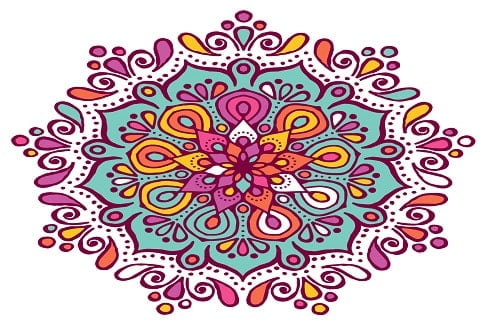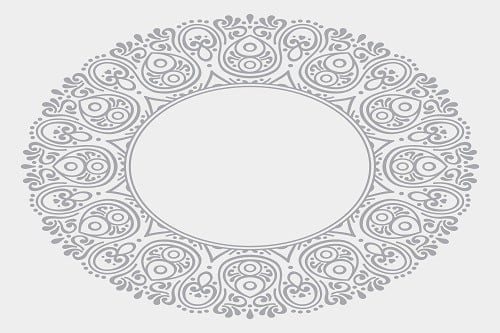Table of Contents
Mandala art is an appreciated art form across the art industry. Consisting of intricate designs confined to a circular boundary, the mandala has gained popularity for the meaning and details of the style.
While the art may have you intrigued, the meditative and symbolic meaning behind these intricate circles is profound and goes far beyond its visual appearance. So, let’s delve deeper into knowing about creative mandala art, and who knows, you might get interested in creating one too!
What is Mandala art?

Mandalas are circles within a square boundary arranged into different sections. These sections are organized around a focal point and produced on surfaces such as paper and cloth. Besides, the mandala art has also been built into stone structures and fashioned on bronze plates.
The mandala designs confined to the circular boundary represent different aspects of the world and universe. Additionally, people use these designs as instruments of meditation and symbols of prayer in Tibet, Japan, and China.
The history of the mandala art
The founder of Buddhism, Siddhartha Gautama, was born in the country known as Nepal today. Although his exact birth date is disputed, most historians believe he was born about 560 B.C.
Gautama left his kingdom soon after he gained awareness of human suffering. He did so to gain enlightenment via thoughtful action and meditation.
Gautama soon began preaching his philosophy across different parts of the country. Eventually, the first community of Buddhist monks was established. The monks traveled along the Silk Road, a network of routes connecting the East and the West. As a result, it allowed them to bring Buddhism to other lands.
These monks carried mandalas as they traveled, spreading the art form to other parts of Asia. While the earliest evidence of simple mandala art dates to the first century B. C., they appeared in regions such as Japan, China, and Tibet by the fourth century.

How are mandalas created?

There is a specific process that follows the creation of mandala art. This begins with a ceremony where all monks consecrate the site of the art and use music, chants, and meditation to call forth goodness and healing.
Then, for a period of 10 days, the monks pour grains of colored sand from metal funnels called chak-purs. This process purifies and heals the space and those involved in creating the piece. Soon after the mandala art is complete, they disassemble the art. It symbolizes the impermanence of the world. The disassembled sand is then dispersed to share the blessings with everyone.
The process of painting a mandala, however, is quite systematic:
1. Preparation of surface
First, the artists stretch the cloth on a wooden frame and size it with an application of gelatin. Then, they polish a layer of gesso to create a perfect and smooth surface.
2. Design establishment
The patron is often a decider of what he needs to depict in the creative mandala art. The painter may receive a diagram to get an idea of the same. But, in most cases, the compositions are fixed based on artistic tradition and Buddhist iconography. The painters create the preliminary sketch of the mandala art with a charcoal crayon. On the other hand, the final drawing is reinforced with sketches in black ink.
3. Initial layers of paint
There are two kinds of paints that artists use in mandala art. These are organic dyes and mineral pigments. The brushes are primarily made of fine animal hair attached to a wooden handle. The artists mix the mineral pigments with a binder such as a hide glue before applying it to the paints.
4. Shading and outlining
The shading is a significant part of the painting process and highlights the details that make mandala art so exquisite. Adding to the intricacy and detail of the art, the artists use organic dyes to shade and outline the shapes within the circular boundary.
5. Dusting
Once the painting is complete, most painters finish the work by scraping the surface with a knife edge. This creates an even-textured canvas. Then, the artist dusts the final art with a rag and rubbed it with a tiny ball of grain flour dough. The grain flour dough adds a matte finish to the painting and collects any residual paint dust left behind.
Mandala art– Symbolism

Owing to the intricate nature of the circular patterns, there are common symbols that are present through most mandalas. Traditionally, these designs represent Buddha’s presence of mind in an abstract form, usually depicted by a jewel, flower, tree, or wheel.
The mandala’s center is a dot representing a part of humanity free of any dimensions. This dot is the beginning point of contemplation and devotion to the unknown.
There are dozens of geometrical patterns and lines surrounding this focal point, symbolizing the universe. This is, then, encompassed within an outer circle. The outer circular boundary of the mandala art represents the cyclic nature of human life. You can surely take some inspiration from mandalas to write stories that inspire and spread the meaning of the art.
Some of the most commonly used symbols within mandalas include:
- Sun – The sun represents the universe and carries symbolic meanings related to energy and life.
- Lotus – This is a sacred flower in Buddhism and depicts balance and the human effort to reach enlightenment and spiritual awakening.
- Triangles – Triangles facing upwards represent energy and action. The ones facing downward represent the pursuit of knowledge and creativity.
- Bells – Bells are a symbolic representation of emptying the mind, creating space for the entrance of clarity and wisdom.
- Eight-Spoked Wheel – The eight spokes of a wheel represent the Eightfold Path of Buddhism, which is a set of practices that allow rebirth and liberation.
Key takeaways
- Mandalas are among the most recognized pieces of art appreciated by millions around the world.
- Despite making their way into contemporary art and fashion, mandalas have a humble beginning rooted in Buddhism.
- The intricate processes involved in creating mandala art contribute significantly to its beauty and exquisiteness.
- Mandalas are rich in meaning and symbolism, allowing individuals to connect with the true meaning of the piece.
We hope you enjoyed this blog on mandala art! If you have any questions/suggestions, then feel free to reach out to us. Alternatively, you can also drop a comment below!
FAQs
Q1. Can I learn to do mandala art myself?
Answer – Yes, there are several tutorials available online that will help you learn the skills required to create beautiful mandalas.
Q2. Why did the Buddhist monks disassemble the created mandalas?
Answer – Monks often disassembled the intricate mandalas created to recognize the fleeting and momentary nature of life.
Q3. What do mandalas represent in time?
Answer – Mandalas represent 40 days in religious and spiritual processes. This is the time required for a human system to complete one physiological cycle.






